Diego Rivera
Diego María de la Concepción Juan Nepomuceno Estanislao de la Rivera y Barrientos Acosta y Rodríguez (* December 8 or December 13, 1886 in Guanajuato; † November 24, 1957 in Mexico City) was a Mexican painter. He is considered, along with David Alfaro Siqueiros and José Clemente Orozco, the most important modernist painters in Mexico. Together they were known as Los Tres Grandes (The Big Three).
Diego Rivera worked in Europe from 1907 to 1921, and in the United States in the early and late 1930s. In his panel paintings, Rivera adapted many different styles in rapid succession and was involved with Cubism for a long time. During his time in Europe, he was in contact with leading exponents of Modern Art such as Picasso, Braque, and Gris. After his return to Mexico, Diego Rivera worked primarily on his large mural projects, which he painted in the Palacio Nacional, the Palacio de Bellas Artes, the Secretaría de Educación Pública, and in various institutions in the United States, for example. These murales, which he saw as a contribution to popular education, contributed in large part to Rivera's fame and success. The other facets of his oeuvre took a back seat to them.
The exact number of his panel paintings is not known, oil paintings by Rivera, previously unknown, are still being found. Many of them were portraits and self-portraits, a large number also showed Mexican motifs. The latter in particular, as well as variations on his mural motifs, were popular with American tourists. In addition, Rivera also made drawings and illustrations and designed costumes and sets for a theater production. These aspects of his oeuvre have not yet been addressed in detail in the literature on Rivera.
Rivera joined the Mexican Communist Party in 1922 and was a member of its executive committee for a time. He traveled to the Soviet Union in 1927 for the anniversary of the October Revolution, intending to contribute to artistic development there; however, because of his criticism of Stalinist policies, he was advised to return to Mexico. Because of his critical position on Joseph Stalin and the government orders Rivera accepted, the Mexican Communist Party expelled him in 1929, but accepted one of his requests for readmission in 1954.
In the 1930s, Rivera turned to the ideas of Trotskyism. He campaigned for Leon Trotsky to be granted exile in Mexico and briefly hosted him in his home. After political and personal disagreements with Trotsky, the Mexican artist severed ties in 1939. Diego Rivera's political convictions were also reflected in his works, in which he propagated communist ideas and repeatedly immortalized leading figures of socialism and communism. In connection with his political activities, Rivera also published articles and was involved in the publication of left-wing magazines. Rivera married the artist Frida Kahlo, who shared his political beliefs, in 1929.
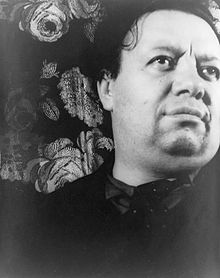
Diego Rivera, Portrait of Carl van Vechten, 1932
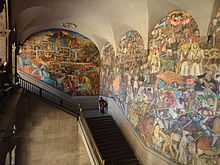
View of two of the frescoes of the Epic of the Mexican People in the Palacio Nacional. This is one of Rivera's most famous and important works.
Plant
Diego Rivera's body of work includes panels, murals, mosaics, and drawings. The murales, in particular, are key to understanding his work and shaped his reception as the most important and influential contemporary Mexican artist. Rivera's works were often associated with Socialist Realism, as they frequently expressed his political point of view. In fact, however, there were few stylistic points of contact. Rivera's style and aesthetic, expressed primarily in his large murals, were based on Italian Renaissance frescoes, the Cubist conception of space, classical proportions, Futurism's depiction of movement, and pre-Columbian art. His subjects were not limited to the observation of social realities; he also devoted himself to complex historical and allegorical narratives. In doing so, he developed his own unique modes of expression.
Blackboard pictures
The exact number of Diego Rivera's panel paintings is not known. New, previously unknown works appear again and again. They often take a back seat to the murals, but are of great importance for tracing Rivera's artistic development and as a reference point for his further works. In the works of his training period in Mexico from 1897 to 1907 and his time in Europe from 1907 to 1921, the development of an artist can be traced who adapted and further developed a wide variety of artistic currents and schools in his works within a short period of time. Rivera continued this learning process throughout his life.
In his first paintings Diego Rivera strove to meet the taste of the Mexican bourgeoisie at the beginning of the 20th century and thus become the most successful painter in Mexico. For this reason, he painted mainly social themes, following the style of his Madrid teacher Eduardo Chicharro as well as Ignacio Zulaogas. He also used an expansive symbolism with decadentist motifs from the landscapes of Flanders that he had traveled.
Cubist works
|
|
|
|
| - The Mathematician, 1918Oil |
| (External links, please note copyrights) |
In Paris, during his first stay in Europe, Rivera had come into contact with Post-Impressionism, which had become a reference for modern painting, which is why he returned to this city in 1911 after a short stay in Mexico. During his second stay in Paris, he created around 200 Cubist works and for a time belonged to the Cubist group, until he broke with this style in a dispute. Diego Rivera came to Cubism through the study of Mannerist painting and the landscape paintings of El Greco. In addition, Ángel Zárraga showed him the compositional and optical distortions of modernism. Subsequently, Rivera created some precubist works before actually painting in a cubist manner from 1913 to 1918, not only adapting the geometric form of appearance, but also being aware of the revolutionary content of cubism for the creation of time and space. Rivera did not merely follow the theories of Georges Braque and Pablo Picasso, but developed his own point of view. One of Rivera's signature Cubist works is Sailors at Breakfast from 1914, a painting in which Diego Rivera applied a kind of compositional grid in an attempt to create simultaneity. The painting depicts a man whose blue and white striped shirt and pompom cap with the word patrie identify him as a French sailor. He is seated behind a table and is included in the composition grid. In his use of this compositional method, Diego Rivera followed Juan Gris, who designed a different object in each field in a consistently maintained perspective, as Rivera did here with the glass and the fish.
Another outstanding work of Rivera's Cubist phase is Zapatista Landscape - The Guerrillero, in which the artist expressed his sympathy for the revolutionary developments in his homeland and his admiration for Emiliano Zapata. This iconographic portrait of the revolutionary leader, with its symbols referencing the Mexican Revolution, such as the Zapatista hat, sarape, rifle, and cartridge belt, were considered too permissive by some orthodox exponents of Cubism. The resulting controversy led to Rivera's departure from Cubism. He turned to landscape painting inspired by Paul Cézanne, and in 1918 produced the paintings The Mathematician and Still Life with Flowers, which echoed academic painting.
Portraits and self-portraits
|
|
|
|
| - Portrait of Ruth Rivera, 1949 |
| - Portrait Natasha Zakólkowa Gelman, 1943115 |
| - The Sons of My Father (Portrait of Modesto and Jesús Sánchez), 193042 |
| (External links, please note copyrights) |
The vast majority of Rivera's panel paintings are portraits. In these, he went beyond the simple depiction of the person and expanded this classical genre by adding psychological and symbolic references to the person depicted. One of the works that exemplifies this genre in Rivera's oeuvre is the 1938 portrait of Lupe Marín, which depicts Guadalupe Marín, whom Rivera had previously immortalized in paintings and murals. The painting shows the model sitting on a chair centrally in the composition. Her back is reflected in a mirror. Brown tones and the white of her dress dominate in color. Rivera refers to various artistic models in his depiction. The exaggerated proportions and pose, for example, are borrowed from El Greco, while the reflection refers to Velázquez, Manet and Ingres. The complex structure of the composition, on the other hand, with its overlapping and interconnected planes and axes, shows parallels to Paul Cézanne. In this portrait, however, Diego Rivera also made direct reference to his fresco in the Escuela Nacional Preparatoria, where he depicted the model as Tlazolteotl, the goddess of purification. In his portrait of Marín, Rivera refers to the best-known depiction of this goddess, which is in Washington, D.C., in the Dumbarton Oaks collection and shows her giving birth to a human being. Marín's facial expression is clearly borrowed from this statue.
Rivera also used the mirror motif in the portrait Ruth Rivera from 1949, which shows his daughter in a back view with her face turned towards the viewer. She holds a mirror that shows her face in profile, framed in sunny yellow, and wears strappy sandals and a white tunic, reminiscent of a figure from classical antiquity. This depiction of family members and caregivers, as in the case of his daughter Ruth or Lupe Marín, was nevertheless the exception in Diego Rivera's oeuvre. Most of the portraits were commissioned works, such as the portrait Natasha Zakólkowa Gelman from 1946, which shows the wife of the film producer Jacques Gelman in a white evening dress on a couch. Behind her upper body and head and parallel to her lower body are draped white calla. The sitter's body position refers to the shape of the flower, while conversely the flower is meant to refer to the essence of the distinguished woman. In other portraits, Rivera used clothing that alluded to Mexico in its coloration. In addition to these commissioned works, he also produced numerous portraits of Indian children, such as The Sons of My Father (Portrait of Modesto and Jesús Sánchez) from 1930. These paintings were particularly popular with tourists as souvenirs.
Throughout his career, Diego Rivera painted numerous self-portraits. These usually showed him as a chest piece, shoulder piece or head picture. His main interest was his face, while the background was usually simply executed. In contrast to the commissioned portraits, in which he idealized the sitters, Rivera portrayed himself extremely realistically in his self-portraits. He was aware that he did not conform to the ideal of beauty, especially as he grew older. In the painting The ravages of time from 1949, Rivera presented himself as a gray-haired man with a face furrowed by wrinkles. In the background of the painting he showed various scenes from his life. In caricatures, Diego Rivera depicted himself several times as a frog or toad. He also used these as attributes in some of his portraits.
Mexico
|
|
|
|
|
|
|
|
| (External links, please note copyrights) |
Another central theme of Rivera's paintings was Mexico. Inspired by his teacher José María Velasco during his training, Diego Rivera painted, for example, the landscape The Tenne from 1904, which shows a farmer and a plough pulled by horses in the central foreground. On the right edge of the picture is a barn, to the left and in the background the picture opens through a gate into the landscape, which ends in the background at the volcano Popocatépetl. Following Velasco, Rivera endeavored to depict the typical colorfulness of the Mexican landscape in the painting. The use of light also goes back to the teacher.
A motif that appeared several times in Rivera's work were flower sellers, which he painted from 1925 and which were successful with the public. The flowers were not decorative elements, but had an emblematic meaning. Diego Rivera knew flower symbolism from before the Spanish conquests. With a painting depicting sellers of calla, Rivera achieved an acquisition prize at a Pan-American exhibition in Los Angeles in 1925; the painting was acquired by the Los Angeles County Museum of Art. It depicted a religious celebration at the Santa Anita Canal, which was part of the vanished canal network in and around Mexico City. In addition, Rivera depicted customs in his panels as in the Christmas Customs series of 1953 and 1954. The second panel is titled The Children Ask for Shelter (Los niños pidiendo posada). It shows Indian children and their parents with candles in a nighttime procession. In the background is an expanse of water reflecting the moon, with Mary and Joseph with the donkey on their journey to Bethlehem at the front border. Diego Rivera thus addressed the theme of popular piety.
In 1956, during a recreational stay on the coast, Diego Rivera produced a series of small-format seascapes under the title Dusk in Acapulco. Rivera painted the sunsets in bright, emotionally charged colors. These color experiments were an exception in Rivera's body of work. The sea in these seascapes is peaceful. The paintings represent Diego Rivera's need for harmony and peace at the end of his life.
Murales
Mexican muralismo between 1921 and 1974 was the first independent American contribution to 20th-century art. Diego Rivera was not the first painter of murales, nor was he an undisputed leading figure or the most important theoretician of the muralists, but he was undisputedly one of the most important representatives of this group, along with David Alfaro Siqueiros and José Clemente Orozco. His murals also occupy a prominent position in Diego Rivera's oeuvre and attracted more attention than his panel paintings, drawings, and illustrations. After returning from France in 1921, Diego Rivera, still under the impression of the frescoes he had previously seen in Italy, turned to mural painting, which was seen by the Minister of Education, José Vasconcelos, as a means of spreading the ideals of the Revolution and educating the people. He produced his first mural starting in January 1922 in the Bolívar Amphitheatre of the Escuela Nacional Preparatoria; it was the touchstone and prelude to his career as a muralist and of muralismo in general. Large and prestigious commissions followed for Rivera in the Secretaría de Educación Pública, the Palacio Nacional and the Palacio de Bellas Artes. He also produced several murales in the United States.
One of the main motifs that runs through the mural projects throughout Rivera's career is creation. In addition, he often thematized his political point of view, immortalizing communist ideas and personalities, in part expressing the idea of Pan-Americanism. In a large number of representations he thematized Mexican history, especially with regard to its pre-Columbian period. At the beginning of his work as a muralist, Diego Rivera was still strongly influenced by European art. Over time, however, he increasingly developed his own style, in which he incorporated Mexican elements.
Escuela Nacional Preparatoria
| - The Creation, (La Creación) 1921-23Fresco |
| (External links, please note copyrights) |
Diego Rivera made his first mural at the Escuela Nacional Preparatoria. There, in the Simón Bolívar Auditorium, is the painting The Creation. From the artist's point of view, the work remained unfinished. Instead of painting a single wall, Rivera had originally planned to decorate the entire auditorium with the work The Fundamental History of Mankind. Initial ideas for this artwork emerged early on. After the opening of the new ballroom in September 1910, the idea for a mural emerged, which Rivera was also considered to execute, but whose plans were not pursued due to the course of the Mexican Revolution. Rivera probably visited the room in late 1910; during his second visit to Europe, he possessed blueprints of the assembly hall.
The first sketch for this mural project was made during Rivera's stay in Italy. On it there is a reference to Perugia. There he was able to see a two-part fresco in the church of San Severo, the upper part of which had been painted by Raphael and the lower part by Perugino. The paintings, each divided vertically into three parts, influenced Rivera's murals in form and composition. In the First Segment, Raphael depicted the Holy Spirit as the energy of creation, while Rivera depicted a cosmic force. In the middle segment, Raphael depicted Christ as Ecce homo, while Rivera depicted the first man. In the last segment, the Mexican artist refers to Perugino in the design of the figures. Both Perugino's fresco and Rivera's mural feature an opening in the center. The former was used to place a figure of a saint, while in the assembly hall an organ was placed in it. Rivera's design was based on basic geometric forms and followed the golden section.
In November 1921, Diego Rivera began sketches for the 109.64 square meter mural, which he completed in 1923. In it, he combined Mexican and European elements in accordance with his claim to transfer Mexican tradition into the modern art of the 20th century. For example, he depicted a typical Mexican forest with a heron and an ocelot, while giving the figures the physique and skin color of mestizos. The niche is dominated by a large male figure with outstretched arms. On the pictorial axis above him is a blue semicircle surrounded by a rainbow and three pairs of hands that create man and dispense primordial energy. In the figures, apart from the two figures of the primordial couple at the bottom left and right of the picture, the human virtues and abilities are depicted. The semicircle in the upper centre of the picture is divided into four equilateral triangles in which numbers are indicated by stars: In the first triangle it is three, in the second four, in the third ten and in the fourth two. This refers to the number symbolism of the Pythagoreans, whose special significance of the number ten emphasizes the third triangle in its meaning. The first and fourth triangles refer to the primordial couple, embodied by the naked woman on the left and the naked man on the right side of the wall. The number of stars of both triangles corresponds to five, which was also part of Pythagorean numerical mysticism. The four stars of the second triangle refer to the four mathemata, geometry, arithmetic, astronomy and musicology. The four is also repeated in the pairs of hands, three of which surround the circle and one of which belongs to the great figure representing humanity as a whole. This symbolism, used by Rivera, refers to education and the pursuit of virtue, which were to be propagated in this painting.
For his fresco Rivera used the technique of encaustic. He drew on the dry plaster and applied the color pigments dissolved in wax. These were then burned in with a welding torch.
Secretaría de Educación Pública
In March 1922, Diego Rivera was commissioned by José Vasconcelos, together with a group of young painters, to paint the three arcaded floors of the two courtyards in the Secretaría de Educación Pública, while other artists were to decorate the interiors of the ministry. The two courtyards are referred to as the Courtyard of Work and the Courtyard of Celebration, after the thematic decoration provided by Rivera's mural cycles, and together they form the work Political Dreaming of the Mexican People. Rivera's work continued from 1923 to 1928, the project temporarily stalled when Vasconcelos resigned as Minister of Education as a result of political disputes. The work was a political work of art. During the years the paintings were being created, both the politics of Mexico and the artist's political position changed greatly. At the beginning of the work Rivera was a leading member of the Mexican Communist Party; by the end of the work he was critical of Joseph Stalin and encountered increasing criticism even within the party. A year after its completion, Rivera was even expelled from it. Politically, the victorious revolutionary forces at the beginning of the 1920s could hold on to power only with difficulty and were attacked by conservative forces, the government was allied with the Communist Party. Over time the government managed to stabilize, by the end of the 1920s the Communists were almost driven underground. The murals are a work of art in which these developments are expressed. They combine a wide variety of elements that can be described as realistic, revolutionary, classical, socialist and nationalist. Rivera turned to Mexico as a subject and developed his own style in which he incorporated Mexican elements.
For the decoration of the courtyards of the Ministry of Education, Diego Rivera made more than 100 murals. In them he depicted many ideas, some of them contradictory. They cannot be summarized under any overarching metaphysical theme; Rivera negotiated incompatibilities, resistances, and differences in them. He took a back seat to the work itself, abstracting rather than immortalizing himself in the images, eclectically drawing on European painting, film, politics, and anthropology. In doing so, he used a very direct form of rendering his subjects, showing the people in their actual places, with emblems corresponding to the meaning of the symbols shown. In the Courtyard of Work, Diego Rivera developed an allegory of the elite's understanding; in the Courtyard of Feasts, he showed the crowds.
The murales in the courtyard of the work form a coherent cycle. The central image of this cycle is located in the central mural field of the second floor. It is the fresco The Brotherhood (La fraternidad), 3.93 metres high and 6.48 metres wide, which shows the alliance of peasants and workers under the care of a sun god. The deity, who is Apollo, spreads his arms in the shape of a cross over the two men in a cave. These two represent the workers and peasants as the bearers of the revolution. This union is the Bolshevik ideal, although in Mexico it was under different auspices, since the main bearers of the revolution were not the workers but the peasants. But it also symbolizes the union of man and woman, which is furthermore expressed in the attributes hammer and sickle, which refer to Demeter and Hephaistos. Next to Apollo on the right are the three apotheoses The Preserver, The Herald and The Distributor, which are repeated on the opposite wall. This is an allegorical representation of the Eucharist. Rivera thus integrated religious symbolism into the symbolic canon of a secular state. It also echoes Plato's Allegory of the Cave. Rivera's idealism is expressed in the figure of Apollo, for instead of martyrdom or passion, redemption lies in the rational, pure, and radiant male figure. Other motifs in the Court of Labour include The Liberation of the Unfree Worker (La liberación del péon) and The Teacher in the Countryside (La maestra rural), topped by the supraporte Landscape (Paisaje), or various representations of activity such as The Foundry (La fundición), The Mine (La minería), Potters (Alfareros), Entrance to the Mine (Entrada a la mina) and The Sugar Cane Factory (La zafara). In addition, there are some grisaille, mainly made in the mezzanine, which have esoteric meanings.
· Court of work
·
The Herald
·
The liberation of the unfree worker
·
The teacher in the country
·
The Foundry and The Mining
·
Potter
·
Symbol (The Agriculture), Grisaille
·
Symbol of work
·
The chemistry
The Courtyard of Festivals thematizes the project of establishing a new calendar. On the ground floor, on the south, north and west walls, there are the central murales The Allocation of Common Pastures, The Street Market and Assembly, which show secular celebrations. They are large door-spanning compositions, while the side wall panels show religious celebrations. The paintings show the mass of people and refer to reality, while The Courtyard of Work also has a metaphysical reference. The granting of communal pastures refers to one of the central demands of the Mexican Revolution. Rivera imaged the transfer of expropriated land to the community as a new social contract. At the center of the mural, an official leads the assembly with an expansive gesture. While the men stand in the streets, the women are on the roofs of the houses. In addition, deceased people are also depicted, such as Emiliano Zapata, who is sitting on a horse on the right edge of the picture. In the way they are depicted, Diego Rivera's murales are reminiscent of the depictions of choirs of angels in the Renaissance, such as in paintings by Fra Angelico. This strictly ordered composition reflects the strong ritualization of village politics. With Assembly, Rivera produced a doctrinaire fresco in which he deliberately worked with left and right as principles of order. On the left, in Bolshevism the side of the progressive and revolutionary class, the painter showed the workers in the form of two injured figures teaching children. The workers' leader with raised fist speaks to the workers on the left half of the wall. On the right side, the people are shown shadowed, while on the left side they are in the light. Through this use of light, Rivera demonstrated the difference between left and right. On the right edge of the painting in the foreground are Zapta and Felipe Carillo Puerto, the governor of Yucatán, two of the slain heroes of the revolution. The street market sets the scene for the government's attempt to strengthen agriculture and revive popular commerce from the pre-capitalist era. Rivera did not strive for compositional order in this mural as much as he allowed the multitude of people to appear in waves, deliberately showing the confusion in the marketplace. This large mural, in contrast to the former two, harkens back to ancient traditions rather than breaking with them. In addition, other festivals and events related to the course of the year were depicted in the courtyard, such as Day of the Dead, The Corn Festival, and The Harvest. On the first floor, Rivera painted the coats of arms of the states, and on the second floor, the Ballad of the Peasant Revolution. In one of the central frescoes of this cycle, In the Arsenal (en el arsenal), Rivera depicted the young Frida Kahlo, whom he had met shortly before, handing out rifles to the revolting workers.
· Court of the feasts
·
Assembly
·
The street market
·
Day of the Dead
·
The Harvest and The Corn Festival
·
Mexico
·
In the arsenal
·
Emiliano Zapata
·
Communion on Wall Street
The murales in the Ministry of Education were intended to represent the new reality after the Revolution. As a result of the upheavals, an extensive interdisciplinary study was produced under the direction of Manuel Gamio and published in 1921 as The Population of the Teotihuacán Valley. It echoed older racial theories about the mestizos, understanding evolution as a progression toward the complex, while promoting the mestizo as the ideal. Diego Rivera drew on photographs from the publication to depict dark-skinned, stocky peasants and workers with pointed and blunt noses dressed in white. In doing so, he lent social legitimacy to the research and theories disseminated in The People of the Teotihuacán Valley.
Palacio Nacional
Diego Rivera's main work of muralism are the murals in the Palacio Nacional, Mexico's parliament building and seat of government. Between 1929 and 1935 he painted the Epic of the Mexican People in the main stairwell, followed by Precolonial and Colonial Mexico in a corridor on the first floor between 1941 and 1952.
The epic of the Mexican people covers a total of 277 square meters of wall space in the central stairwell. The north wall shows the mural The Old Mexico, on the west wall Rivera painted the fresco From the Conquest to 1930, and on the south wall he completed the cycle with Mexico Today and Tomorrow. They form a circular homogeneous whole. The first phase of the work at the Palacio Nacional was begun by Diego Rivera in May 1929 and lasted 18 months, concluding on October 15, 1930, with the painting of the signature on the fresco The Old Mexico. While this work was still in progress, Rivera sketched the other murals. In November of that year, he traveled to the United States, leaving the mural unfinished. In June 1931, Diego Rivera returned to Mexico City to paint the main mural. He worked on it for the five months from June 9 to November 10, 1931, before traveling again to paint in the United States. Rivera completed his fresco cycle in the stairwell of the Palacio Nacional with Mexico Today and Tomorrow, painted between November 1934 and November 20, 1935. The signature of this fresco celebrated the 25th anniversary of the Mexican Revolution.
At the center of the composition of the fresco Ancient Mexico is Quetzalcoatl in front of the Pyramid of the Sun and Moon of Teotihuacán, thus integrating the lord of Mesoamerican cultures and the largest pre-Columbian metropolis into the image. The volcanoes refer to the Anáhuac Valley, from which the Toltecs established their rule. From the volcano in the upper left corner of the picture rises the feathered serpent as the animal embodiment of Quetzalcoatl. It is repeated in the upper right half of the picture, where it bears its human counterpart. In the right half of the painting Diego Rivera depicted craft and agricultural activities, in the left half he showed a warrior on a pyramid to whom tribute is being paid. In the lower left corner is a warlike confrontation between Aztec warriors and the peoples they ruled.
From the conquest to 1930 traces the history after the conquest in episodes that merge into each other. The fresco is divided into three horizontal zones. The lower one depicts the Spanish Conquest of Mexico, the middle episodes of colonization, and the upper one, in the arched panels, the interventions of the 19th century and various actors in late 19th century Mexican politics and history and the Mexican Revolution. In the lower center of the fresco, Rivera painted a battle scene between Spaniards and Aztecs, with the central figure, Hernán Cortés, seated on a horse. From the right side, Spanish soldiers fire muskets and a cannon, highlighting Rivera's technological superiority. In the middle zone of the painting, the colonial period is depicted, such as showing the destruction of Indian culture and Christianization by showing clergymen and Cortéz with his Indian wife Malinche. In the middle of this zone, Mexican independence is pictured. In the upper zone, the American intervention of 1846 to 1848 and the French intervention in Mexico from 1861 to 1867 are shown on the right. In the three central arches, numerous historical figures of the reign of Porfirio Díaz and the Mexican Revolution are depicted. In the centre of the fresco, the heraldic animal of Mexico, the eagle, is depicted atop the opuntia, here holding Indian field signs in its talons instead of the cactus.
The cycle in the staircase of the seat of government was completed by Diego Rivera with the fresco Mexico Today and Tomorrow. In it he devoted himself to the post-revolutionary situation and gave a utopian outlook. On the right edge of the picture, the struggle of the workers with the conservative forces is depicted, and Rivera also showed a hanged worker and peasant. In the upper right corner of the picture, a worker agitates and calls for struggle. Set centrally in the fresco are box-like spatial structures showing, for example, capitalists around a stock ticker, President Plutarco Elías Calles with evil advisors, and the church in a state of debauchery. In the foreground of the picture Rivera painted his wife Frida Kahlo and her sister Cristina as village teachers and towards the left edge of the picture workers. The central figure at the upper middle edge of the picture is Karl Marx, holding a sheet with an excerpt from the CommunistManifesto and pointing with his right arm to the upper left corner of the picture, where Rivera painted the utopia of a socialist future.
Between 1941 and 1952, Diego Rivera painted the cycle Precolonial and Colonial Mexico in a corridor on the first floor of the Government Palace. The frescoes cover a total of 198.92 square meters. Originally, 31 transportable frescoes were planned to be placed on the four sides of the courtyard. In the end, Rivera produced only eleven frescoes and interrupted the project several times. Their theme is a synthetic representation of Mexico's history from pre-Columbian times to the 1917 Constitution, and the reference to Mexico's indigenous cultures, their customs, activities, art, and products aimed to consolidate national identity. Rivera chose colorful and grisaille frescoes as his form of representation. The large fresco The Great Tenochtitlan (View from the Market of Tlatelolco) shows Diego Rivera's vision of the ancient capital of the Aztecs, Tenochtitlan. In front of the panorama of the urban architecture around the Templo Mayor, market activities such as animal trade, trade in foodstuffs and handicraft products, as well as representatives of the various social classes such as merchants, officials, medicine men, warriors and courtesans are depicted. In other wall panels, for example, agriculture with crops unknown to Europeans and individual craft activities are depicted. Another large fresco shows festivals and ceremonies of the Totonaks and the culture of El Tajín, such as the worship of the goddess Chicomecoatl. In the foreground, visitors can be seen making offerings to the site. In the last fresco of this cycle, Rivera devoted himself to the Spanish conquest of Mexico and the colonial period. He wanted above all to show the subjugation and exploitation of the Indians and depicted HernánCortés in a grotesque manner. In this last fresco of the project, which ultimately remained unfinished, it becomes clear that Diego Rivera wanted to juxtapose the idealized splendor of the pre-Columbian period with his negative judgment of the conquista and conquistadors.
· Pre-colonial and colonial Mexico
·
The trade with the Chalchihuitee
·
Painters and dyers (Tarasca culture)
·
Festivals and ceremonies (Totonaca culture)
·
The corn
·
The arrival of Hernan Cortez in Veracruz
Detroit Institute of Arts
Diego Rivera's most outstanding work from his time in the United States are his murales at the Detroit Institute of Arts. They are considered the best work of Mexican muralists in the United States. The subject of these frescoes was the industry of Detroit. The frescoes cover 433.68 square feet and have been given various titles such as Detroit Industry, Dynamic Detroit, and Man and Machine. Rivera visited the Ford River Rouge Complex in Dearborn, a factory facility where all automobile manufacturing took place. He arrived in Detroit when Michigan's auto industry was in crisis, but did not depict it in his works, instead narrating an evolution of the industry and glorifying technological progress. During his explorations of the Ford plant, which lasted about a month, he made numerous sketches. In addition, he and Frida Kahlo were accompanied by William J. Stettler, who took photographs that Rivera used in his work, as well as film footage. In addition to these impressions of industrial work, however, Rivera also drew on earlier works in his oeuvre. Moreover, he was so fascinated by industry that he wanted to paint the entire courtyard instead of the two wall surfaces he had ordered. For this he received the approval of the relevant commission on 10 June 1932. On 25 July of that year, Rivera began the painting work.
In the courtyard of the Detroit Institute of Arts, Rivera produced a closed cycle in which he depicted the entire process of automobile production. He showed the various steps in the processing of raw materials and the different activities of the workers throughout the day. The cycle begins on the east wall of the courtyard with a depiction of the origin of life. This is symbolized by a human fetus. To the left and right below him are ploughshares as symbols of human industrial activity. The wall also depicts women with grain and fruit. On the west wall, air, water, and energy are symbolized by the aviation industry, shipping, and electricity production. Rivera painted civil aviation in contrast to its military use. This juxtaposition was echoed in the symbols of the dove and the eagle for peace and war. In addition, the painter also referenced a branch of Ford's business with this depiction. The north wall and south wall are each surmounted by two guardian figures representing the four races represented in the American labor force, holding coal, iron, lime, and sand as mineral resources in their hands. These elements were the basic materials of automobile production. In the two main panels of the north and south walls, Rivera painted the production of the Ford V-8. Some of the workers are portraits of Ford employees and Rivera's assistants.
The murales that Diego Rivera painted for the Detroit Institute of Arts were subject to criticism for several reasons. On the one hand, American painters, who were not commissioned during the Great Depression, criticized the fact that Rivera was a Mexican who received a lucrative commission; on the other hand, the content of the frescoes was criticized as being intended to advertise Ford. It was primarily with regard to the latter charge that Diego Rivera was defended by the museum's director. Edsel B. Ford knew what Rivera would paint when he pledged his support for the project. His support and Rivera's visits to the Ford plant were also based on the fact that Ford was the only auto industrialist with an interest in modern art. Another critic was Paul Cret, architect of the Detroit Institute of Arts, who saw the painting of the walls as an affront to his architecture. In addition, some of Rivera's motifs met with criticism from church and religious circles and were called pornographic, for example. The press took a stand against the murales, while other artists and art experts such as museum directors, whom the director had approached, defended the paintings. In the end, Ford backed the artist and the work, the reception of the frescoes by the workers was positive, and the tenor of national reporting also changed for the better.
Palacio de Bellas Artes
Diego Rivera's murales Man at the Crossroads/Man controls the Universe (El hombre en el cruce de caminos/El hombre controlador del universo) for Rockefeller Center, where the painting was destroyed, and the Palacio de Bellas Artes, where it was ultimately executed, address the social, political, and economic issues of the mid-1930s. The composition of the mural is very dense and also tightly structured visually. The central figure is a worker whose head, shoulders, arms, and gloved hands are positioned where two large ellipses intersect. In one ellipse is a telescopic image of the sun, moon, and a nebula of stars; in the other, a microscope image of a cell. The worker uses a joystick and a control panel to control a large machine that controls the irrigation system of the plants located at the bottom of the image, thus increasing their yield. Overall, he represents man using modern technology to control science, medicine, industry, and agriculture. The worker has a scowl on his face, which Rivera used to refer to the fact that a fundamental decision is about to be made. To his right and left, the two choices are represented by elements Rivera considered typical of the Soviet and American social systems. In the left half of the painting, to the right of the worker, war scenes with fighter planes, tanks, and gas mask-wearing soldiers with rifles and a flamethrower can be seen above. Below, Rivera showed mounted police beating demonstrating unemployed men at the corner of Wall Street and Second Avenue. Next to it, he depicted financial magnate John D. Rockefeller, Jr. along with people gambling, flirting, and drinking. To the left of the worker, on the right side of the fresco, on the other hand, a worker and a soldier can be seen shaking hands in front of Lenin. In front of the Kremlin and Lenin's mausoleum, male and female workers peacefully gather in Red Square. In addition, female athletes can be seen running. The decision of the worker in the middle of the composition for one of the two options has not yet been made. Diego Rivera made this clear by giving both the same space.
Originally, this fresco was to be painted in the newly built Rockefeller Center, where it was to be titled Man at the Crossroads, Looking Uncertain but Hopeful, with a Grand Vision of a New and Better Future. Rivera had been invited to compete alongside Henri Matisse and Pablo Picasso, but turned it down. In the end, he received the commission anyway, because Picasso did not respond to the invitation at all and Matisse did not see an appropriate place for his art in the busy entrance hall. Rockefeller's advisor, Hartley Burr Alexander, suggested an explicitly political motif for the proposed mural. Rockefeller did pursue a socio-political line that included works councils and a balance between industrialists and workers, yet the appointment of a famously communist artist like Rivera was surprising. One role in this may have been the support of Abby Aldrich Rockefeller, who had previously collected artworks by Diego Rivera. Added to this was his high international reputation and notoriety for murals in Mexico and the United States.
Diego Rivera arrived in New York at the end of March 1933 to begin the fresco. During this time, the political situation had been exacerbated by the policies of Franklin D. Roosevelt's New Deal policies and Hitler's appointment as Reich Chancellor. This caused Rivera to change his design. He now placed the individual worker at the center of his composition and he chose drastic imagery to contrast the situation in the United States and the Soviet Union. In addition, he added the portrait of Lenin. The Rockefellers felt increasingly provoked by this ideological development of the painting. In December 1933, John D. Rockefeller, Jr. considered transferring the still unfinished fresco to the Museum of Modern Art. However, this idea was rejected. Eventually, it was destroyed on February 9, 1934. After the destruction of the fresco in New York, Rivera asked the Mexican government for an area where he could paint this image again. He was eventually commissioned to do so at the Palacio de Bellas Artes. Rivera completed the fresco as late as 1934.

Man at the Crossroads/Man controls the Universe , detail with portrait of Lenin
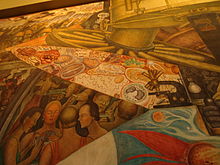
Man at the crossroads/Man controls the universe , detail of the ellipse with microscope and cell images

Man at the Crossroads/Human Control of the Universe
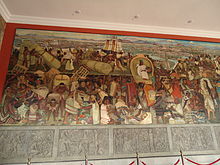
The great Tenochtitlan (view from the market of Tlatelolco)
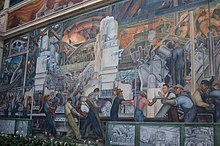
Detail of the north wall of the courtyard in the Detroit Institute of Arts
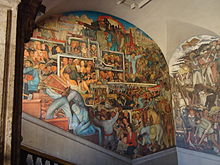
Mexico today and tomorrow
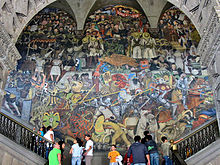
From the conquest to 1930

Old Mexico

Play media file Epic of the Mexican People at the Palacio Nacional, 1929-1935

The allocation of communal pastures
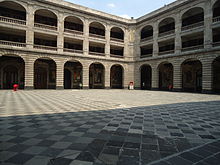
View into the courtyard of work
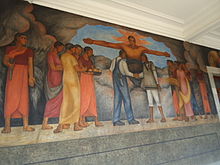
The Brotherhood
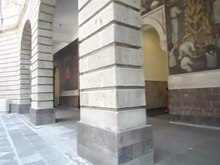
Play media file Court of Feasts and Court of Labour, 1923-1928
Search within the encyclopedia




















